Table of Contents
- Introduction
- Editor’s Choice
- Global Speech and Voice Recognition Market Overview
- Number of Voice Search Users Around the Globe
- Adoption of Voice Recognition Across Various Departments
- Demographics of Speech and Voice Recognition Technology Users
- Use of Voice Technology by Professionals in Different Industries
- Voice Assistants Mostly Used by Users
- Accuracy of Voice Assistants
- How Voice Technology Drives Value (By Vertical)
- Barriers to Adoption of Speech and Voice Recognition Technology Assistants
- Future Outlook for Voice Assistants
Introduction
According to Speech and Voice Recognition Statistics, Speech and voice recognition technology enables computers to understand human speech by converting spoken words into text or instructions.
This involves capturing audio through microphones, processing it digitally, and analyzing sound patterns to recognize individual sounds, words, and phrases.
It has diverse applications in virtual assistants, transcription services, accessibility tools, security systems, and automotive interfaces, facilitating hands-free operation and improving accessibility.
However, challenges like ensuring accuracy, addressing privacy concerns, and integrating with existing systems persist.
Advances such as refined learning methods and cloud-based solutions improve accuracy and scalability, while personalized features customize systems to users’ distinct speech patterns.
Editor’s Choice
- By 2032, The global speech and voice recognition market revenue will reach USD 83.0 billion.
- In 2023, the market expanded to USD 17.0 billion, with speech recognition generating USD 11.1 billion, voice recognition USD 4.8 billion, and other technologies USD 1.1 billion.
- The global speech and voice recognition market is segmented by deployment mode, with most of the market share held by cloud-based solutions at 59%.
- As of the latest data, the global speech recognition market revenue showcases a notable dominance by the United States, with revenues reaching USD 3039 million.
- 31% of voice users view cleanliness as a notable advantage of voice technology.
- Customer service leads the way with a high adoption rate of 81%, indicating its widespread integration to enhance customer interactions and support services.
- In subtitling and closed captioning, 14% of professionals utilize voice technology, followed by 12% in customer experience and analytics.
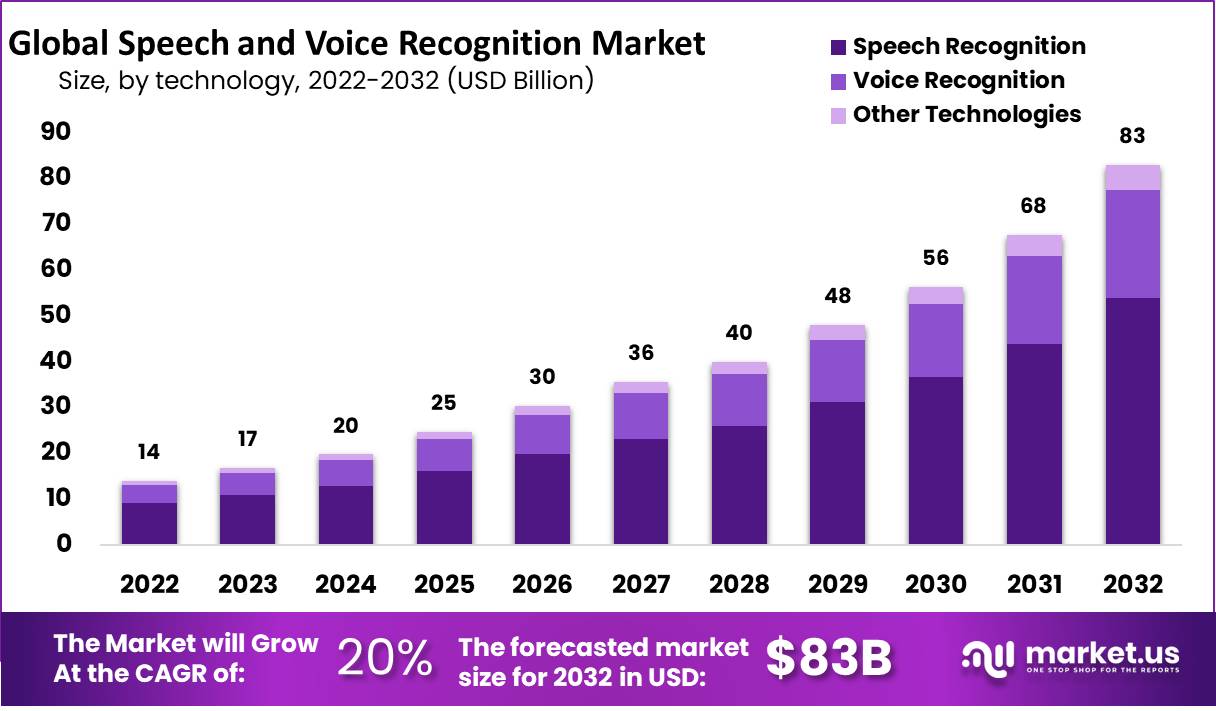
Global Speech and Voice Recognition Market Overview
Global Speech and Voice Recognition Market Size
- The global speech and voice recognition market has experienced steady growth in revenue over the past decade at a CAGR of 20%.
- Starting at USD 14.0 billion in 2022, the market saw a significant increase to USD 17.0 billion in 2023, followed by continued expansion to USD 20.0 billion in 2024.
- By 2031, revenue is forecasted to reach USD 68.0 billion, further climbing to USD 83.0 billion by 2032.
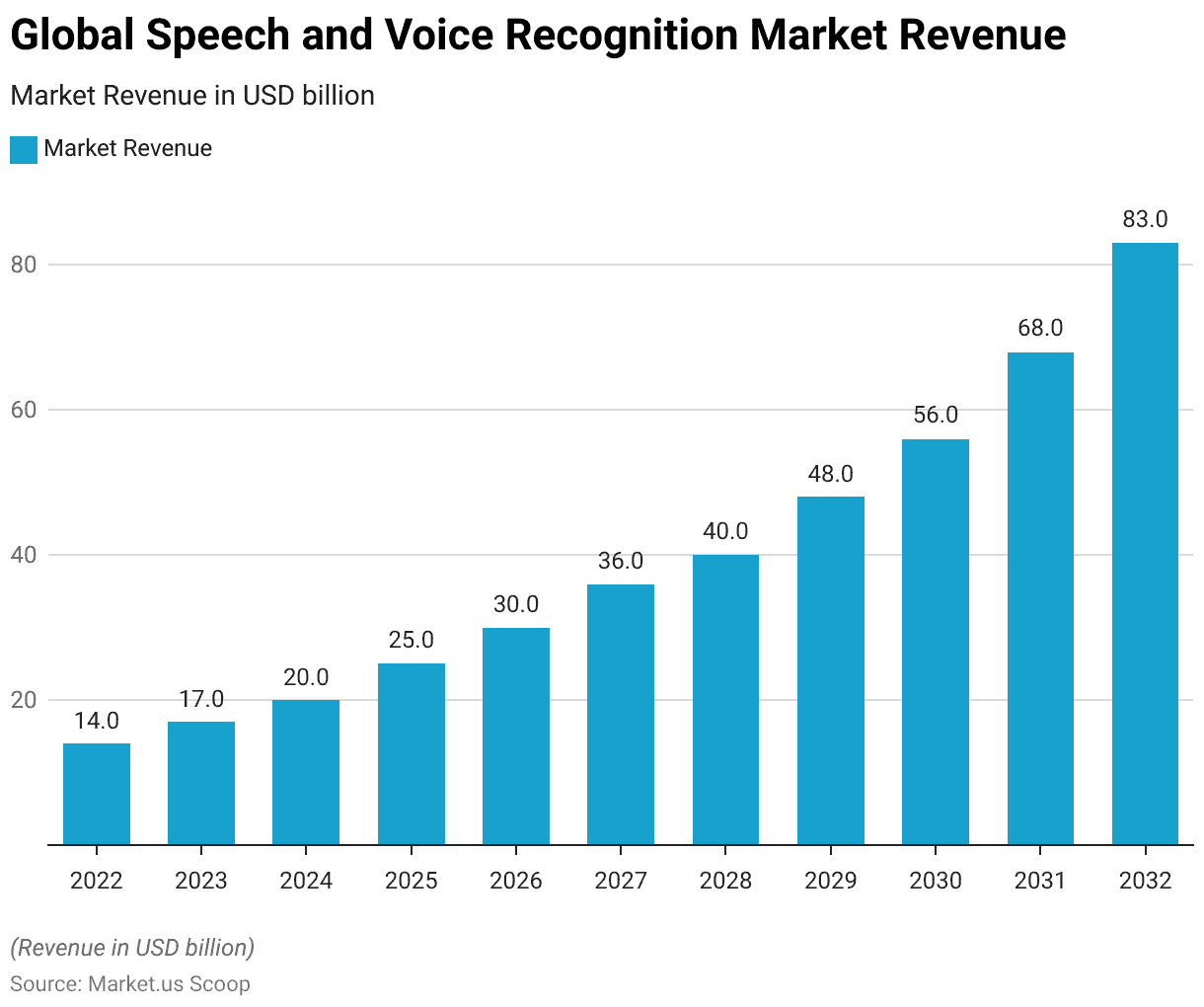
Speech and Voice Recognition Market Size – By Technology
- The global speech and voice recognition market has steadily grown, with revenues increasing consistently.
- In 2022, the total market revenue reached USD 14.0 billion, with speech recognition accounting for USD 9.1 billion, voice recognition for USD 4.0 billion, and other technologies contributing USD 0.9 billion.
- Subsequently, in 2023, the market expanded to USD 17.0 billion, with speech recognition generating USD 11.1 billion, voice recognition USD 4.8 billion, and other technologies USD 1.1 billion.
- By 2032, the market is expected to exceed USD 83.0 billion, driven by increasing adoption and advancements in speech and voice recognition technologies across various industries.
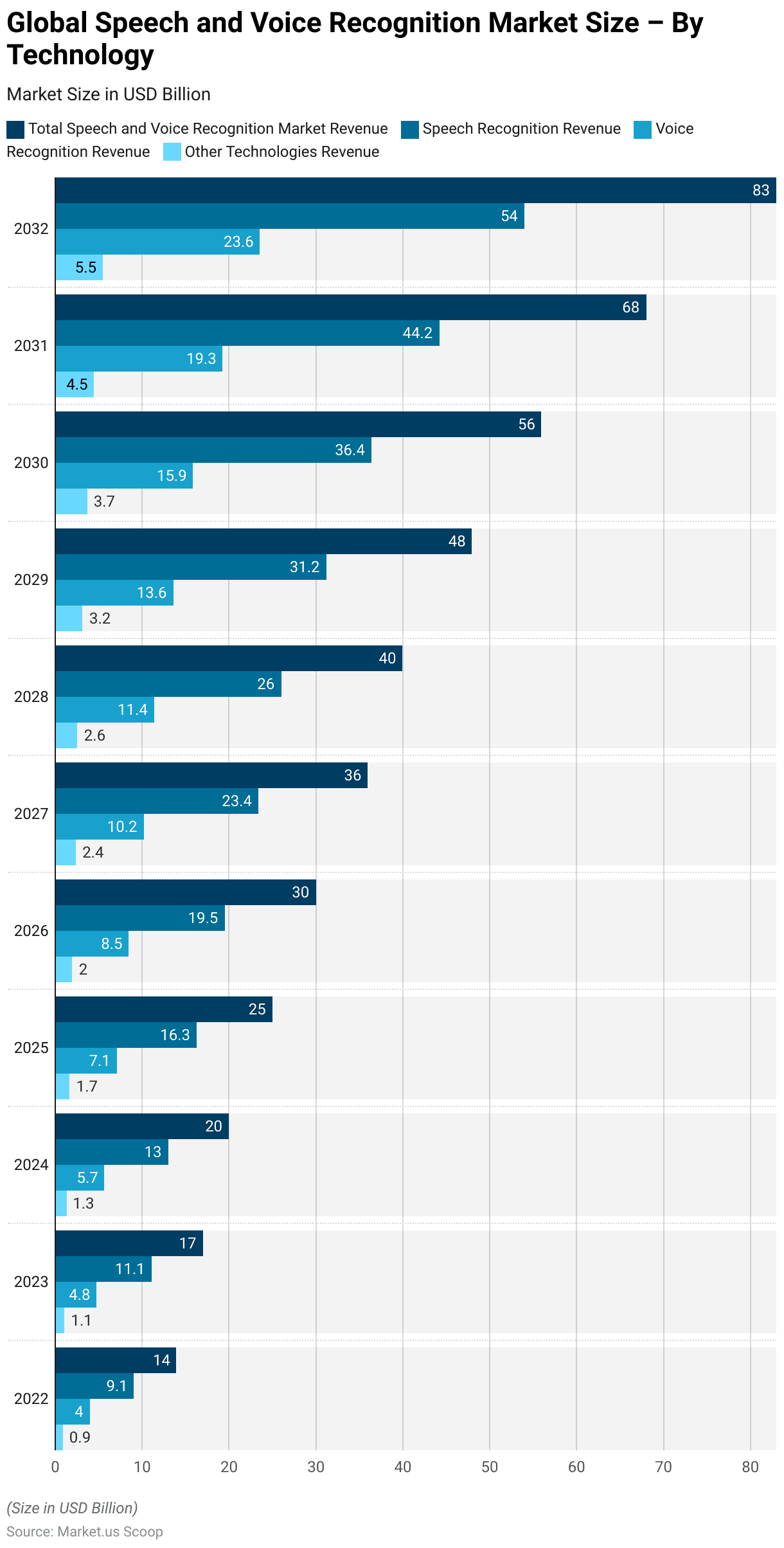
Global Speech and Voice Recognition Market Share – By Deployment Mode
- The global speech and voice recognition market is segmented by deployment mode, with most of the market share held by cloud-based solutions at 59%.
- On-premise deployment, comprising a smaller portion of the market at 41%, remains significant, particularly for organizations requiring greater control over their data and infrastructure.
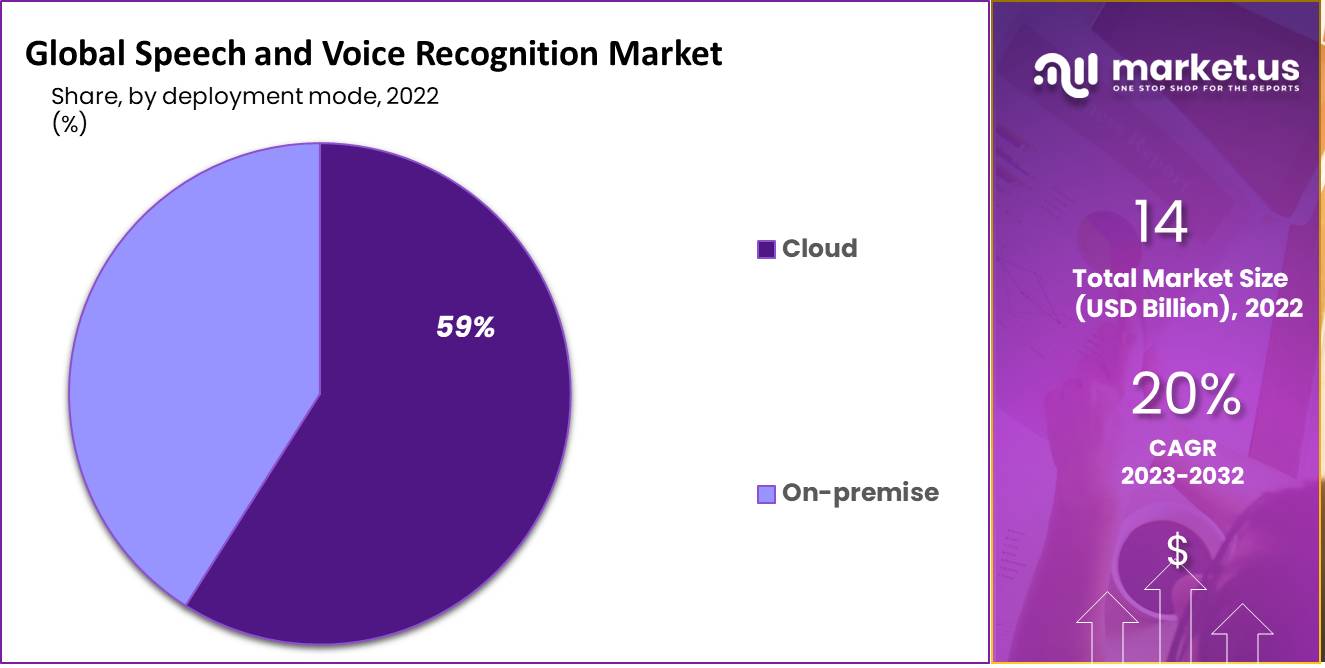
Regional Analysis of Speech Recognition Market
- As of the latest data, the global speech recognition market revenue showcases a notable dominance by the United States, with revenues reaching USD 3039 million.
- Following behind, China emerges as a significant player, albeit with a considerable gap, recording revenues of USD 1051 million.
- Germany and the United Kingdom exhibit substantial contributions, with revenues of USD 360.1 million and USD 342.8 million, respectively.
- Japan closely trails, with revenue figures totaling USD 341.4 million.
- France, Canada, and Australia each demonstrate notable involvement in the market, with revenues standing at USD 232.4 million, USD 210.5 million, and USD 175 million, respectively.
- Italy, South Korea, and the Netherlands exhibit similar revenue figures, ranging from USD 163.9 million to USD 165.6 million.
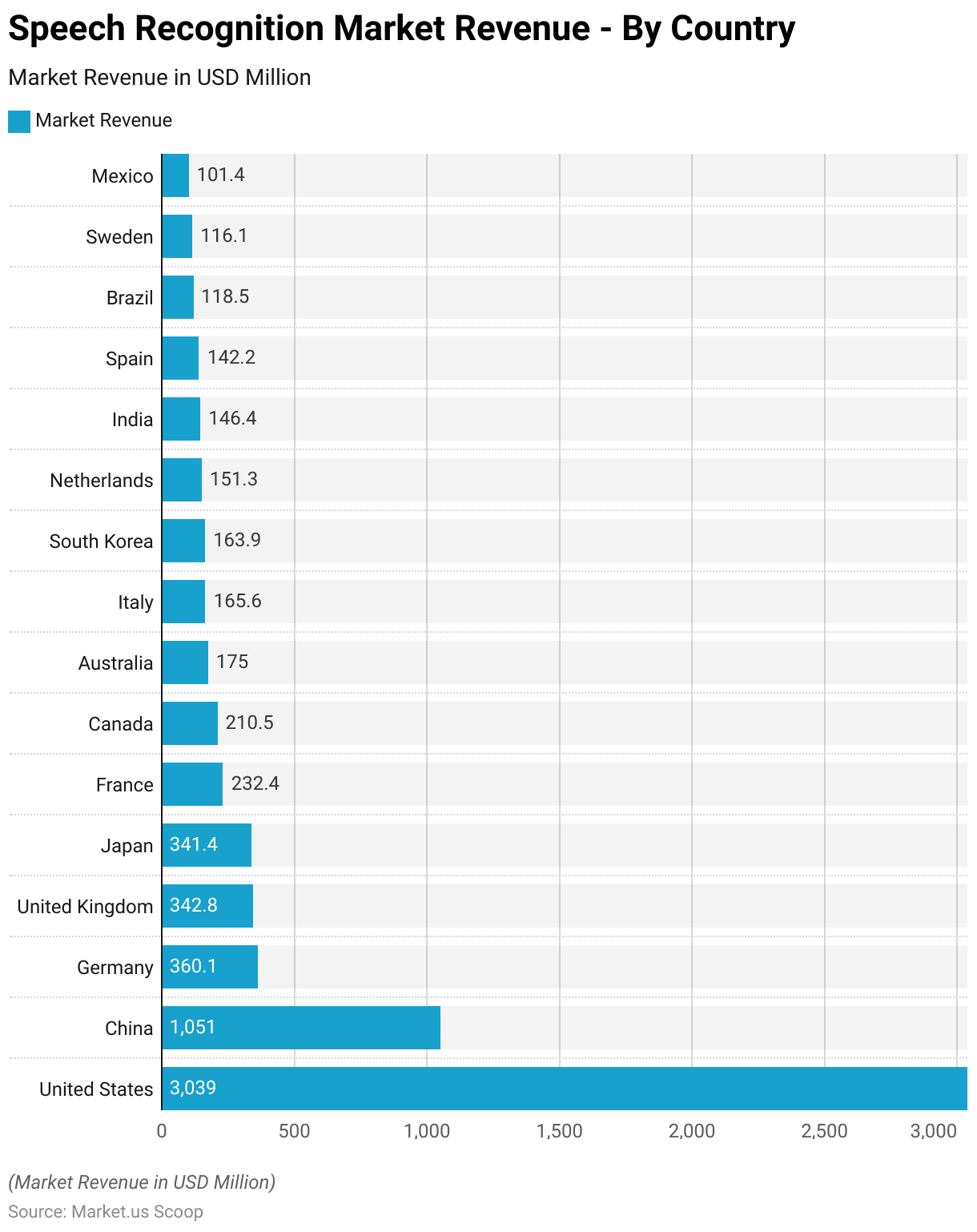
Number of Voice Search Users Around the Globe
- The utilization of voice search technology has experienced a notable upward trajectory over recent years, as evidenced by a steady increase in user numbers.
- In 2017, there were approximately 79.9 million voice search users, which grew substantially to 103.9 million in 2018.
- In the subsequent years, they maintained this upward trajectory, with 132 million users in 2021, 123.5 million users in 2022, and further growth to 125.2 million users in 2023.
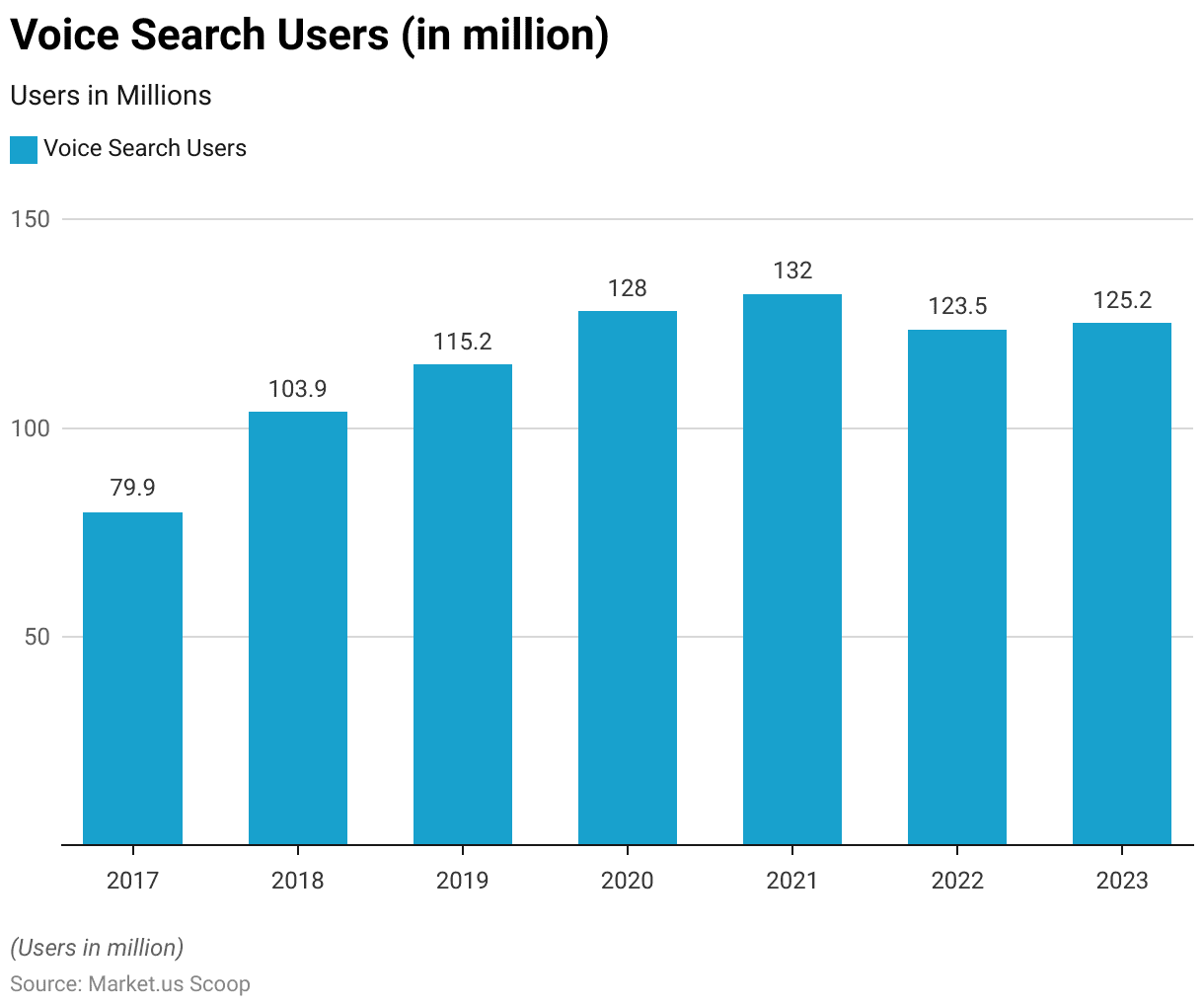
Adoption of Voice Recognition Across Various Departments
- Voice recognition technology adoption varies significantly across different departments within organizations.
- Customer service leads the way with a high adoption rate of 81%, indicating its widespread integration to enhance customer interactions and support services.
- Sales departments also show significant uptake, with 52% adopting voice recognition technology to streamline sales processes and improve efficiency.
- In-store operations and marketing adoption rates stand at 38%, reflecting the utilization of voice technology to optimize operational workflows and enhance marketing strategies.
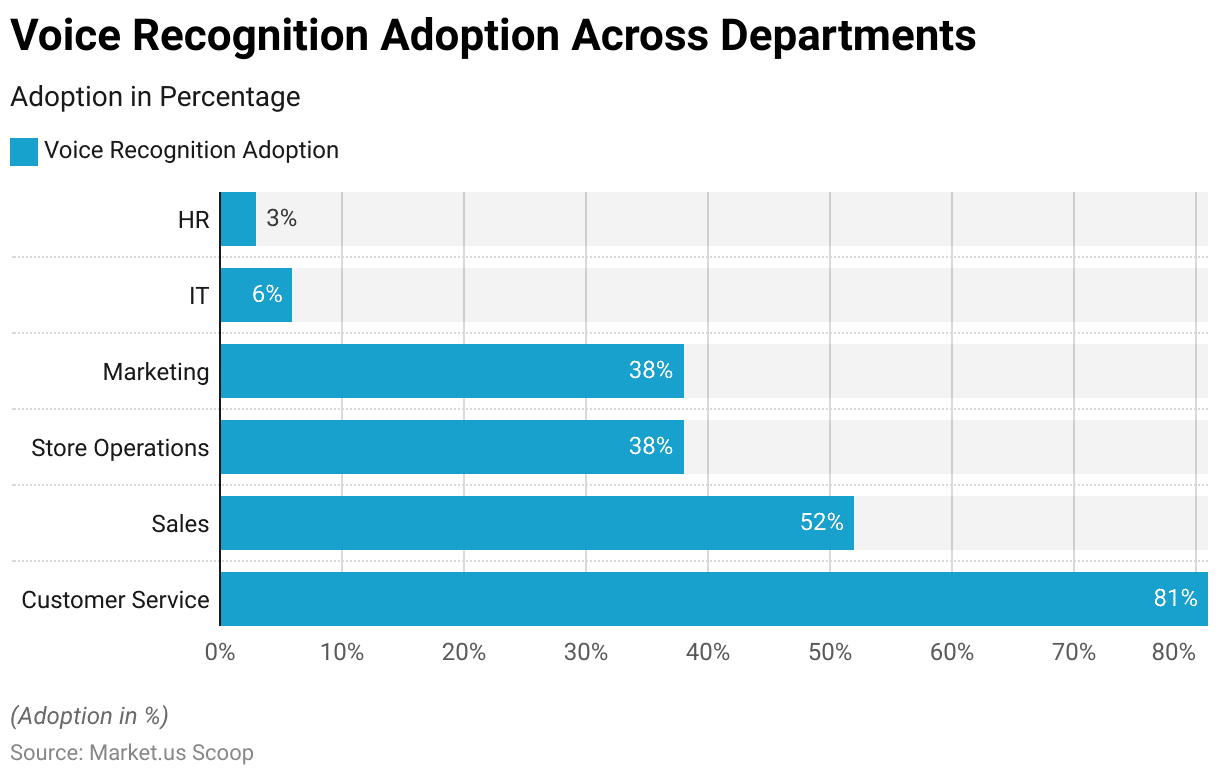
Demographics of Speech and Voice Recognition Technology Users
- The demographics of speech and voice recognition users vary across different devices. Among smartphone users, the highest adoption rates are observed in the 18 to 34 age group, with 77%, followed by 63% in the 35 to 54 age bracket, and 30% among those aged 55 and above.
- Similarly, desktop/laptop usage is more prevalent among younger demographics, with 38% in the 18 to 34 age group, decreasing to 32% and 15% in the 35 to 54 and 55+ age groups, respectively.
- Tablet usage follows a similar trend, with 37% among the 18 to 34 age group, 32% among the 35 to 54 age group, and 9% among those aged 55 and above.
- Smart speaker adoption, however, is highest among the younger demographic, with 34% in the 18 to 34 age group, declining to 19% and 4% in the 35 to 54 and 55+ age groups, respectively.
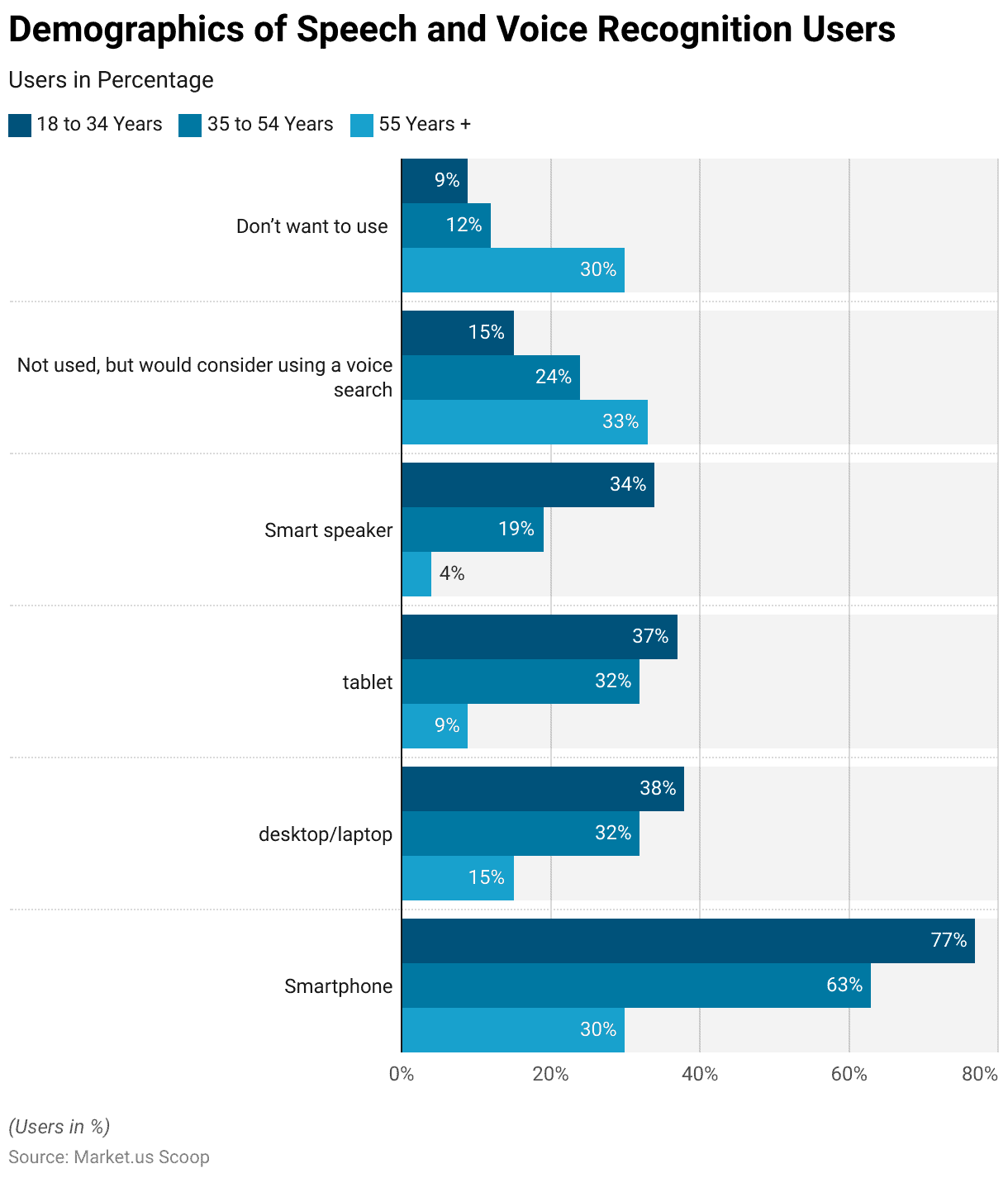
Use of Voice Technology by Professionals in Different Industries
- Voice technology adoption among professionals varies across different industries.
- In subtitling and closed captioning, 14% of professionals utilize voice technology, followed by 12% in customer experience and analytics.
- Media and communications monitoring see a 10% adoption rate, while web conferencing transcription and education, academic, and research transcription stand at 9% and 7%, respectively.
- In the automotive sector, voice technology is employed for command and control purposes by 7% of professionals.
- Digital asset management and chat app messaging industries show relatively lower adoption rates, with 6% and 5%, respectively.
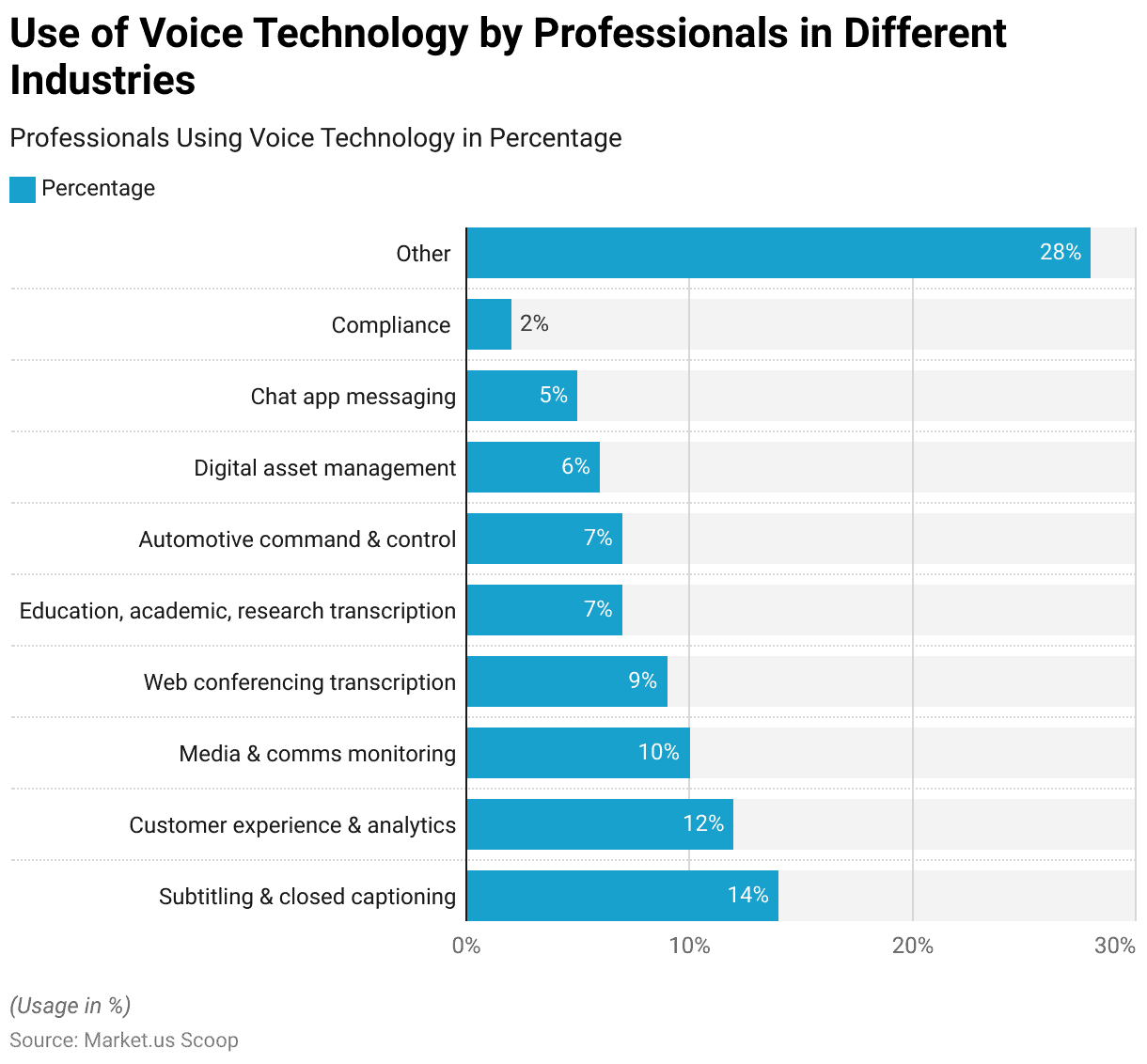
Voice Assistants Mostly Used by Users
- According to recent data, Google Assistant and Apple’s Siri dominate the market share of digital assistants, each holding a substantial 36% of users.
- Following closely behind is Amazon Alexa, capturing 25% of the market.
- Microsoft Cortana trails with 19%, while other digital assistants collectively represent a marginal 1%.
- This distribution underscores the fierce competition among tech giants vying for supremacy in the digital assistant landscape.
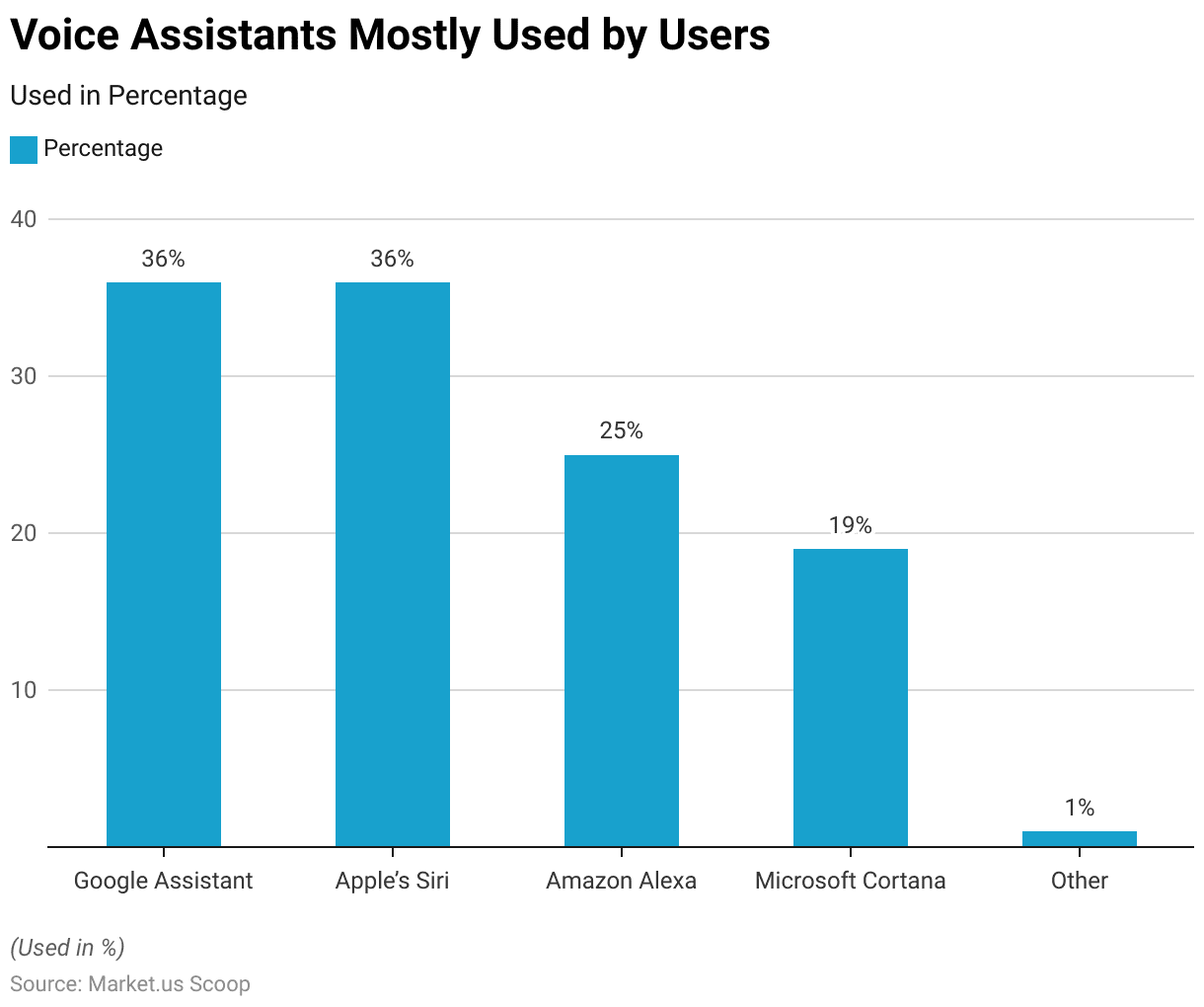
Accuracy of Voice Assistants
- When assessing the accuracy of digital assistants in understanding questions and providing correct answers, Alexa emerges as the top performer, achieving a perfect score of 100% in understanding questions and delivering correct responses 92.90% of the time.
- Siri follows closely, with a 99.80% understanding rate and an 83.10% accuracy in providing correct answers.
- While exhibiting a high understanding rate of 99.90%, Google Assistant lags in accuracy, answering questions correctly 79.80% of the time.
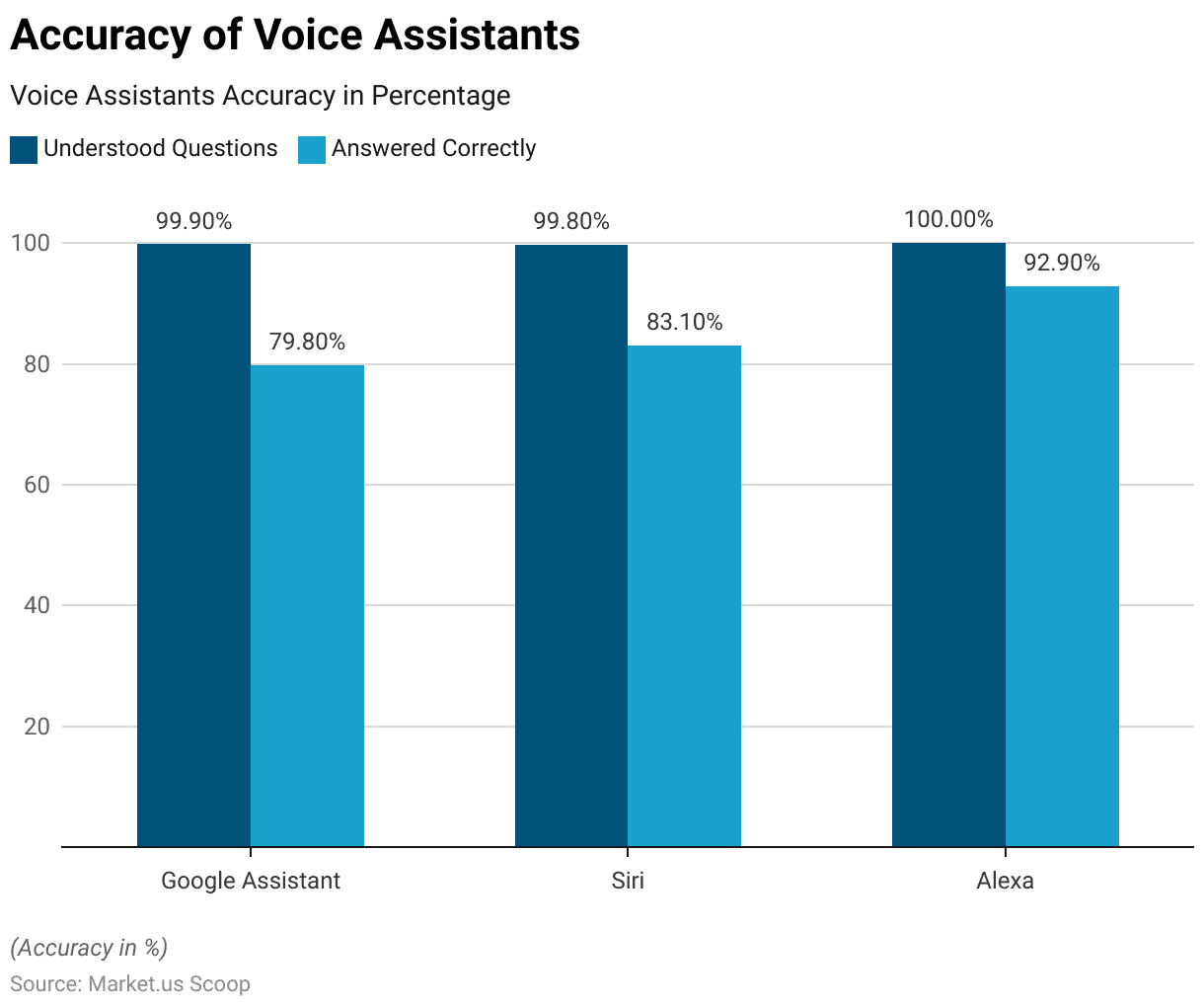
How Voice Technology Drives Value (By Vertical)
- Voice technology drives value across various verticals by addressing key parameters tailored to each industry’s needs.
- In the telecom sector, convenience and speed are paramount, with 77% of respondents highlighting the importance of streamlined interactions.
- Smart home applications prioritize convenience even further, with 90% emphasizing its significance.
- Financial services leverage voice technology to improve customer support (84%) and drive revenue generation (44%).
- Retailers capitalize on voice technology to control brand identity and enhance customer loyalty (66%).
- In transportation, operational efficiencies (78%) and hygiene and safety measures (84%) are prioritized, while the hospitality industry places a strong emphasis on convenience (94%) and customer loyalty (88%).
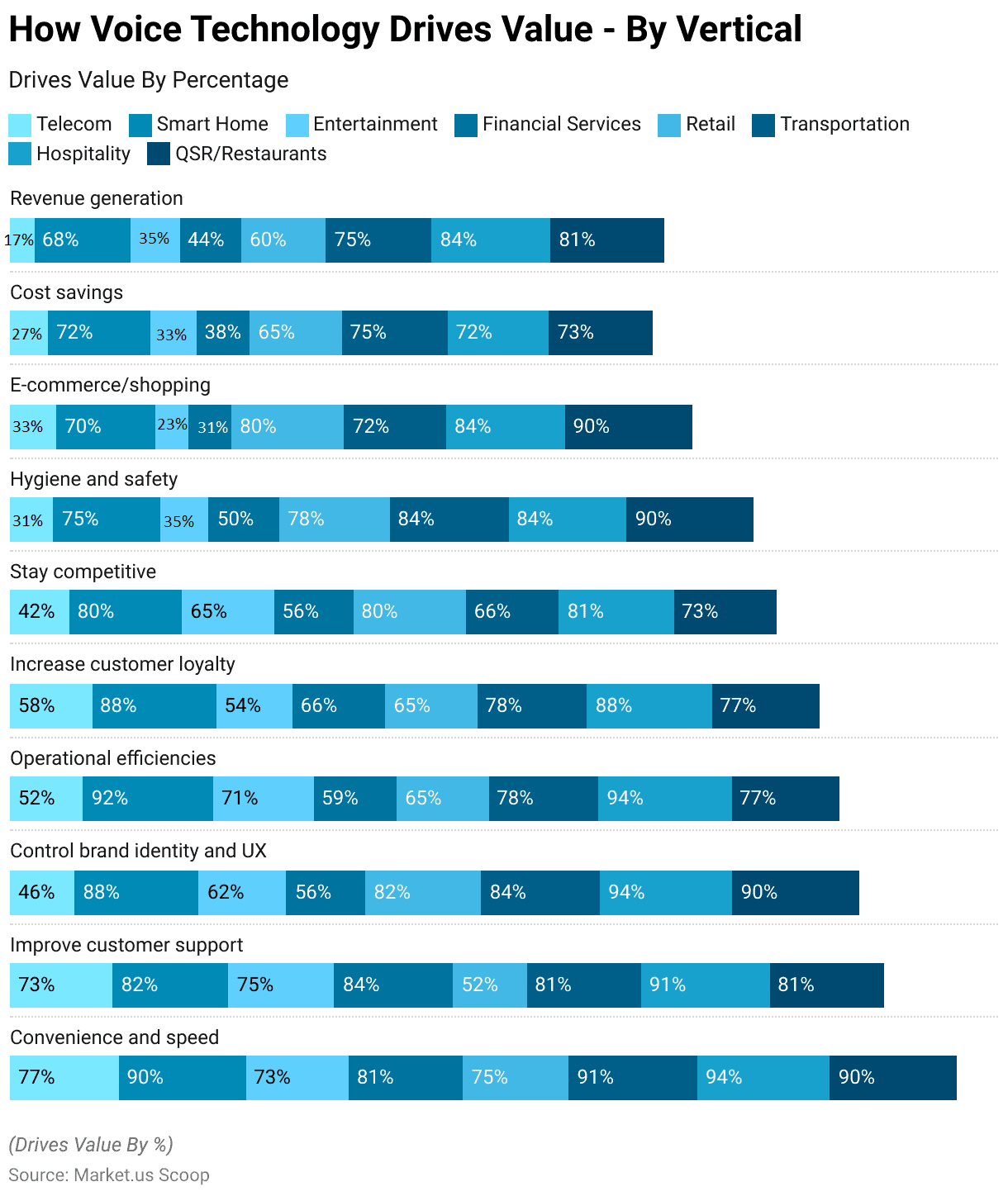
Barriers to Adoption of Speech and Voice Recognition Technology Assistants
- In 2020, most survey participants, accounting for 73%, identified accuracy as a primary obstacle to the widespread adoption of voice technology.
- Additionally, 66% of respondents expressed concerns about recognition issues stemming from accents or dialects, further hindering the adoption of voice technology.
Future Outlook for Voice Assistants
- Consistent customer experiences are a top consideration, cited by 19% of respondents, highlighting the importance of delivering seamless interactions across various touchpoints.
- To broaden their reach, companies aim to increase the number of voice-enabled channels (15%) and expand the breadth of use cases (11%).
- Additionally, there’s a focus on evolving into multimodal experiences (11%) and leveraging data to inform company roadmaps (11%).
- Monetization opportunities are also being explored (9%) alongside efforts to raise awareness, adoption, and engagement (9%).
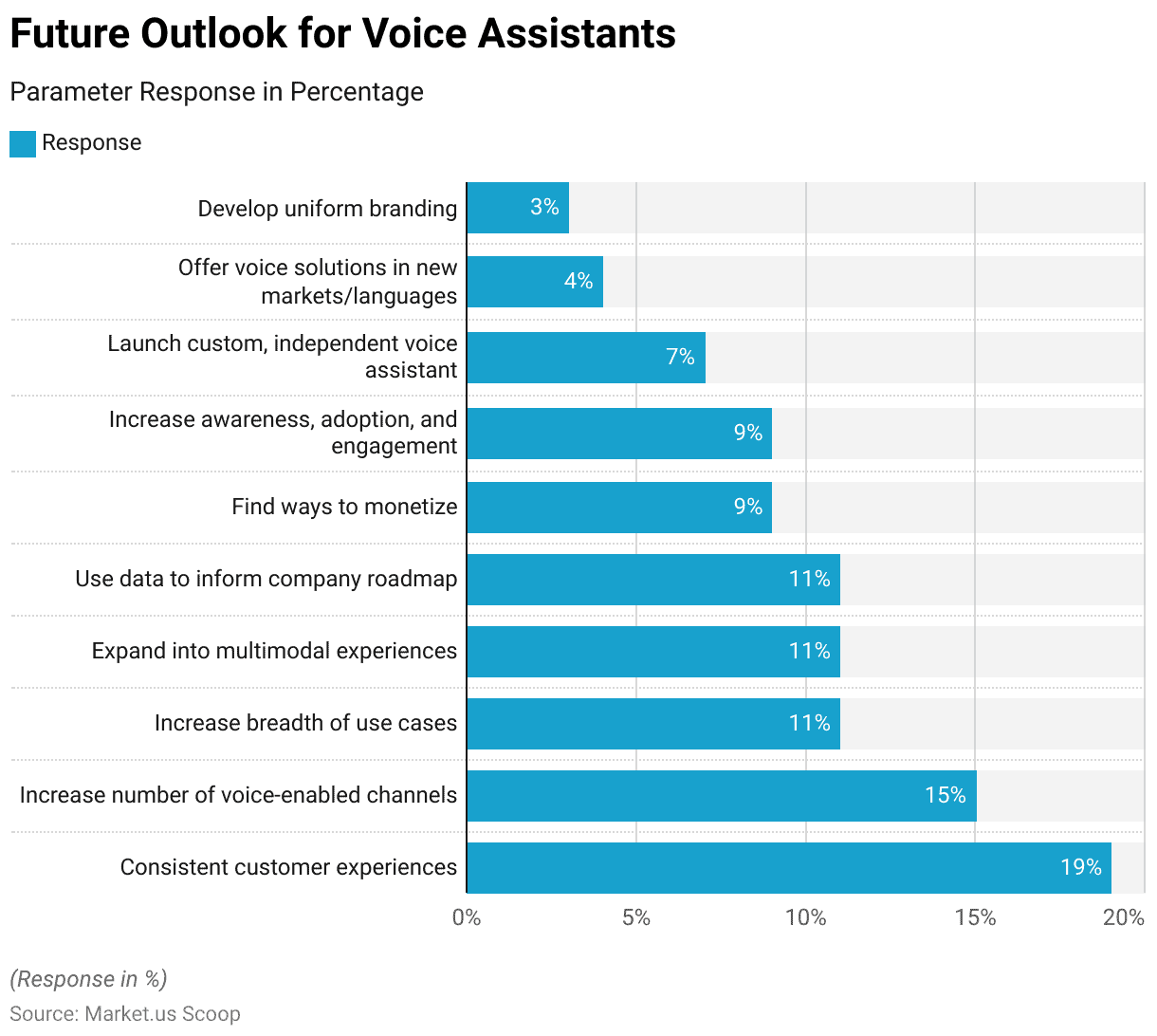
Discuss your needs with our analyst
Please share your requirements with more details so our analyst can check if they can solve your problem(s)



